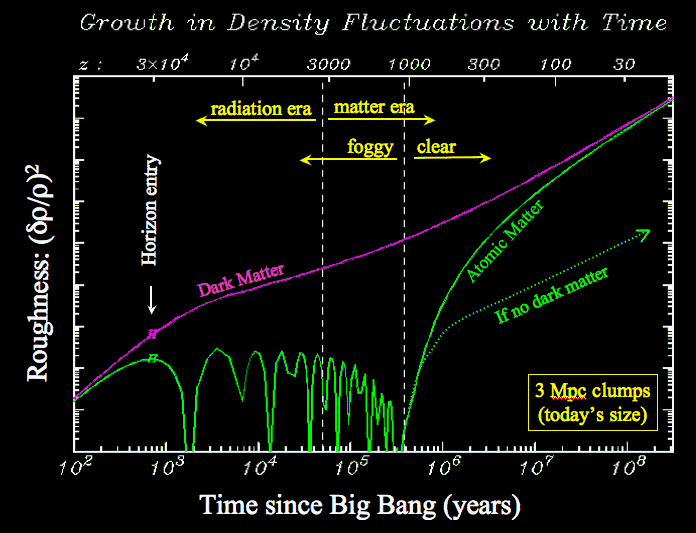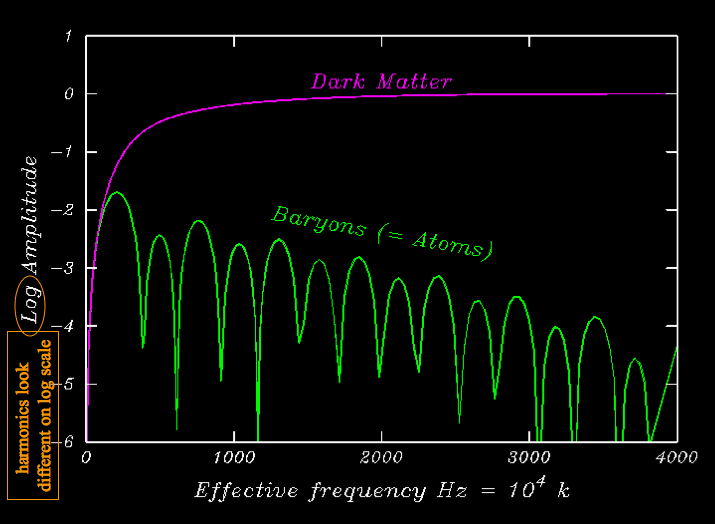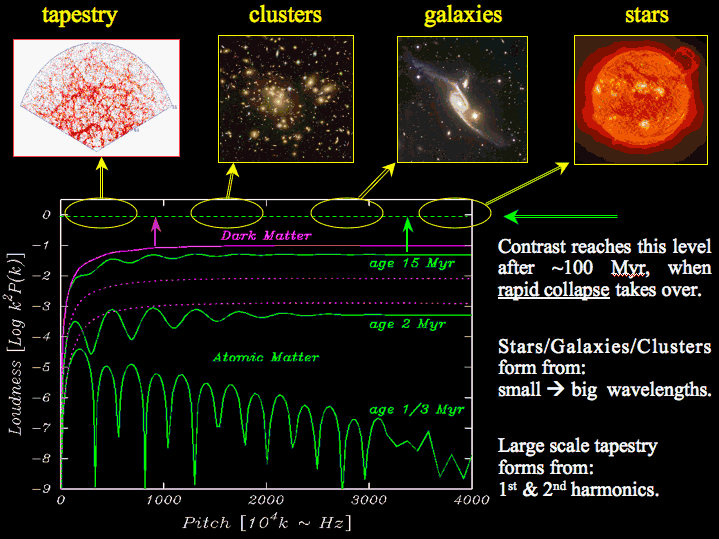
After our recreational break with chord analysis, this next topic is as fascinating as it is challenging — how sound gradually develops, under the guidance of dark matter, to spawn stars, galaxies, clusters, and the cosmic web.
So far, so good: we've followed the growth of sound for the first 400 thousand years – the gas oscillates across ever larger regions with ever greater severity, producing the sound of a building descending scream. What next? These are the first hints of pregnanacy – what about the final birth of stars that is to come? Here's the challenge: how is it possible for this almost uniform gas to ultimately condense into a sparse sea of stars separated by oceans of vacuum? The transformation is huge: at the time of the Microwave Background the gas is smooth to within 0.01%, while the final star/inter-star density contrast is essentially infinite.
The quick answer, which you may have already guessed, is that the peak-trough density contrast continues to grow in strength, from 0.01% variations (110 decibels) through 1% (150 decibels) to 100% (200 decibels). Ultimately the peaks collapse under their own gravity to form stars, while the troughs evacuate to become the spaces between the stars. Seems simple enough, doesn't it?
Well yes, but this is the PG-13 version of an R-rated story — a story of desperate struggle in which our ancestral material was enslaved not once but twice before taking charge of its own destiny. The spawning of the first stars is not unlike human birth – simple in principle, but painfully difficult in practice, and almost miraculous when you consider it in detail. Read on.......
Our PG-13 story omitted two severe problems, both of which stifle stellar gestation and could easily render the Universe stillborn. First, as long as matter and light are bound together in a fog, matter is slave to light – it has absolutely no freedom. It's like a dissenting minority in an oppressive regime: outnumbered a billion to one, light's pressure so dominates that any gravitationally enhanced gathering of matter is ruthlessly suppressed and dispersed. As long as the fog lasts, matter is never free to collapse into stars.
We already know the outcome of this particular struggle; it ends in rapid liberation when the fog clears and the Universe turns transparent – the chains which shackled matter to light are finally broken and matter is set free for the first time.
But freedom is not enough. After such debilitating oppression, the newly liberated matter is not well organized – its sound was too quiet to form stars easily. If left to itself, it would take gravity over 40 billion years to amplify matter's roughness to the point that stars could form — the Universe would even now be only 10% rough, and the era of the first stars would still be far in the future. So..... What happened? What helped matter to get organized and speed up the onset of the first star births?
A silent hidden giant, both master and savior, enters our story.......
The new character that enters our story is Dark Matter. I say enters our story, but in truth it has been there all the time, quietly playing its role, preparing the stage for all that is to come. It went unacknowledged back when we talked about how sound waves are generated (Topic 6). Quite early in the history of the Universe, dark matter took over from light the role "Master of Density" – it came to define the gravitational landscape across which sound waves moved – the hills and valleys were hills and valleys of dark matter.
What is dark matter? We still don't know. We know what it is not — it is not made of protons or neutrons; it is non-baryonic. It is some, as yet unknown, type of particle. All we know about these particles is that they can't collide with photons (they are invisible – hence dark matter); they pass through protons and electrons (we cannot feel them); and they pass through each other. They are extremely elusive. Like everything, however, they both generate and feel gravity's force.
You can think of dark matter as a pervasive invisible heavy gas, with one very odd property: it exerts no pressure. This means it feels no resistance to gravitational clumping. Whereas a normal gas bounces back and forth as sound waves, dark matter quietly keeps on gathering – the valleys get deeper and the hills get higher. Most important: since dark matter is six times more abundant than normal matter, it is the prime mover in the growth of all structure, from stars to the galactic web.
The next figure shows how clumpiness (y-axis) grows with time (x-axis) for dark matter (purple line) and normal matter (green line). See how normal matter is held back as low amplitude sound waves while dark matter clumps continue to grow. Only after the fog clears, and normal matter no-longer feels radiation's pressure, is it free to gravitationally clump up. By then, dark matter valleys are so deep that normal matter simply falls into them, "quickly" matching their overall clumpiness (the green line joins the purple line). The sound volume increases enormously.

|
The green wiggles are the acoustic oscillations. They start when a sound wave first crosses the region (H) and they end when the fog clears. The growth of dark matter clumps is also not uniform, with three distinct periods. In this plot, the clump size is 9 million light years (in today's units).
After the fog clears, there is a drastic change in sound quality as well as sound volume — gradually a hiss is introduced which ultimately becomes overwhelming. Remarkably, normal matter has essentially inherited the sound of dark matter....
Wait a minute, surely this can't be right — after all, dark matter has no pressure and so by definition it has no sound. In human terms; even a zillion dark matter particles could not move your eardrum one jot – they would simply breeze right through your head! Nevertheless, one can still talk about dark matter's "sound spectrum" – except that rather than refer to pressure variations, it refers to a close cousin of pressure, namely density – it describes the "amplitude" of density clumps of different size.
Now, while creation ensures (see topic 13) that the sound spectra of all contents — normal matter, dark matter, light — start out identical, they evolve differently. In particular, pressure halts the clumping of normal matter and introduces harmonics, while dark matter clumps continue to grow at all times. So, after half a million years, the sound spectrum of dark matter is radically different from the sound spectrum of normal matter: it has strong high "frequencies" and no harmonics. The next slide shows these two spectra at 300,000 years: normal matter has very little "roughness", while dark matter is much rougher, even at small (high frequency) scales, and it shows no harmonics, because it feels no pressure.
Roughness Spectra at 300,000 Years

|
"Sound" of Dark Matter
|
A watershed occurs around 400,000 years when the fog clears; light and normal matter can no longer interact – they ignore each other – and the pressure exerted by light on matter quickly dwindles. Matter is released from light's grip and is finally free to move. With its new-found freedom what does it do? It does what gravity tells it to do, which is to fall into whatever valleys are around – and these are the valleys of dark matter. Hence the normal matter begins to take on the irregularities of the dark matter, and in so doing "makes it audible" — it gives voice to this mute giant.
The full process takes time — about 10 million years brings the roughness of the gas to within ~50% of the roughness of the dark matter, and by then most of the gas's harmonics have gone. The sound associated with the gas's pressure variations has changed radically – with high frequencies completely dominating, and the deep roar of the fundamental all but gone. Listen to these sounds in the figure below......

|
|
One detail we've already come across in the previous topic: notice how the even harmonics disappear long before the odd harmonics. From topic 5, recall that even harmonics arise from clumps caught at maximum rarefaction, while odd harmonics arise from clumps caught at maximum compression. With pressure reduced, the gas can't bounce out of the valleys as easily, and the rarefactions get weaker, muting the even harmonics. Conversely, gravity strengthens the odd compression harmonics.
A second, perhaps more important consequence of the loss of pressure when the fog clears, is that true sound waves cease to oscillate — all becomes quiet. I have nevertheless continued to construct sounds from the roughness spectrum. This subtlety is discussed more here.
With all this talk of clumping up, its easy to forget that throughout all this time the Universe is still expanding! Everywhere, the density continues to decrease — roughness is defined relative to the average density, which is itself decreasing. Obviously, if we are to make stars, at some point this expansion must be halted and reversed. This reversal occurs when the density roughness reaches about 100% — clumps are twice the average density. It takes about 10 million years for the roughness to reach a few percent, and a further 100 million to reach 100%. At this point, with local expansion defeated, gravity takes over with a vengeance, and the matter in the clumps undergoes more or less free-fall collapse. The onset of collapse is dramatic and chaotic — never again will the Universe evolve in so simple a manner as in those first 100 million years.
What sized clumps collapsed first? The small ones, since these were the strongest feature in the sound spectrum of the dark matter. What do these small collapsing clumps become? Stars, whose light ends a period of darkness that began when the Universe first turned transparent.

|
From now on, the story is one of assembling ever greater structures — stars are gathered into galaxies, galaxies into clusters, and clusters into the cosmic web. These processes are all reviewed in topic 16. Perhaps most remarkable: for the largest regions the "wave" structure can still be seen in the pattern of galaxies.
Sound waves grow to spawn the first stars, but: